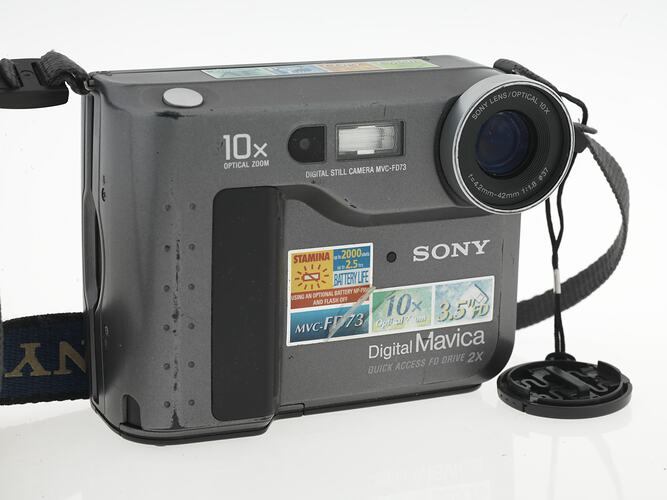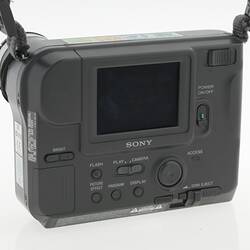Summary
Digital 'Mavica' model MVC-FD73 still camera manufactured by Sony, Japan, 1998.
The model name Mavica stood for MAgnetic VIdeo CAmera, which reflected the early history of this camera range which was analogue rather than digital. The name continued to be used as the range extended into true digital cameras in the late 1990s.
It has 10x optical zoom, flash, and stores its digital images on 3.5" floppy disks. The camera has a digital screen, a simple point and click operating system, and a simple downloading system which worked at any computer without the need for special software or equipment. It stored up to twenty images at low resolution on one floppy disk.
The donor purchased the camera in December 1999 from George's Camera shop in Castlereagh St, Sydney. The price was about $2000. The donor used the camera to take images of bird specimens and habitats as part of his scientific work, as well as for family photos. In 2007 the donor upgraded to a smaller digital camera, and subsequently to another digital camera. In addition, when the donor's work computer was upgraded there was no longer a floppy disk port and consequently he could no longer download images from the camera to the computer, thus making the camera redundant.
The camera has its original rechargeable batteries, battery charging device, a spare set of rechargeable batteries (purchased separately by the donor), and the camera and battery charger manuals.
Sony began as Sony Recording Media and has since been a forerunner in recording and digital technology, producing the first video cassette, 3.5" floppy disk and memory stick among other products.
Physical Description
Camera: metallic and matte grey plastic case, 10 × 13 × 4.5cm. LCD screen 3.7 × 5cm. Sony lens optical zoom 10x, f=4.2mm-42mm 1:1.8 Ø37. Flash on front. Grey, black and blue woven fabric and leather neck strap. 4cm lens cap attached by back cord to camera. Slot for 3.5" floppy disk on left hand side of camera. Battery storage is at bottom of camera. Back of camera has program buttons entitled "flash", "picture effect", "program" "display", play-camera", "access", "power", "disk eject".
Significance
The camera was donated by MV Collections Manager Wayne Longmore. Wayne purchased the camera in December 1999 from George's Camera shop in Castlereagh St, Sydney. The price was $2000 and it was the last on their shelves for the day as a government department had purchased the other four they held earlier that day. At the time, Wayne was working for the Australian Museum and NSW State Forests. He used the camera to take images of bird specimens at the Australian Museum as well as for family photos.
Wayne also used the camera to take photos of the bush, creating a large series of habitat images for the New South Wales Regional Forest Agreement Moree. This was funded by the Federal Government and staffed by NSW State Forests, where Wayne was employed, and NSW National Parks and Wildlife Service. Later Wayne used the camera to capture habitat shots in the Deniliquin area for the CSIRO Division of Sustainable Ecosystems. Wayne later began work at Museum Victoria in 2001, when he was still using the camera.
This Sony camera was one of the first digital cameras made. Sony began as Sony Recording Media and has since been a forerunner in recording and digital technology, producing the first video cassette, 3.5" floppy disk and memory stick, among other products.
The camera appealed to Wayne because of its simplicity in using a 3½ " disk as the memory, which allowed photos to be downloaded at any computer terminal, without any cables, special programmes or awkward equipment. Another of the camera's selling points was that varying quality images could be taken depending on what the user required and how much they needed to store on one floppy disk. Wayne only ever made low resolution images enabling him to record 20 images per disk. The ability to transfer images directly from the camera to computer made photography an easy and affordable hobby at a time when the price of producing slides was going up. Its macro function was also of great use to Wayne, who took two photographs with the camera which were later published in: Longmore, N.W. (2002): Museum Victoria. Bird Observer 819: 33. Although Wayne's original intention in taking the photographs was not for publication, the images produced by the camera were of fine enough quality for this purpose.
In almost 10 years of use the camera always functioned perfectly and is still in good working order, with all of its accessories and manuals. As one of the first ever digital cameras it will make a valuable addition to the Museum's collection of cameras and Sony products (Compact Disc Player, Voice Recorder, GPS Receiver).
In 2007 the donor upgraded to a smaller digital camera, and subsequently to another digital camera.
More Information
-
Collecting Areas
-
Acquisition Information
Donation from N. W. Longmore - Museum Victoria, 29 Mar 2007
-
Manufacturer
-
Inscriptions
Printed on colour stickers, top of camera 'Program AE'; 'Picture Effects'; 'Copy'; 'Email'. Printed on colour stickers on front of camera 'STAMINA up to 2000 shots / up to 2.5 hrs/ BATTERY LIFE / USING AN OPTIONAL BATTERY NP-F550 AND FLASH OFF / MVC-FD73'; '10 X Optical Zoom'; '3.5: FD'. Printed on camera, front , silver lettering '10 x OPTICAL ZOOM" / DIGITAL STILL CAMERA MVC-FD73" / SONY / Digital Mavica / QUICK ACCESS FD DRIVE 2 X'. Printed on camera, back, printed, silver lettering ' POWER ON / OFF / BRIGHT / SONY / FLASH / PLAY / CAMERA / ACCESS / PICTURE EFFECT' and further associated text. Further text on side and top of camera body. Woven into fabric strap, grey lettering ' SONY'.
-
Model Name or Number
-
Brand Names
-
Classification
-
Category
-
Discipline
-
Type of item
-
Overall Dimensions
130 mm (Width), 65 mm (Depth), 105 mm (Height)
Shoulder strap length: 1060mm
-
References
Sony, [Link 1] accessed 07/11/07
-
Keywords
Digital Cameras, Digital Photography, Electric Power Supply Units, Photographic Equipment, Photography


